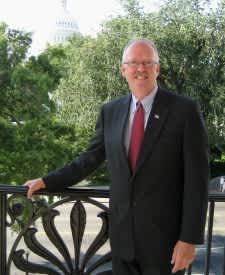U.S. Interior Secretary Jewell Reappoints Pheasants Forever’s Nomsen to Wetlands Post
Pheasants Forever 06.25.14

Pheasants Forever’s Dave Nomsen has been reappointed to the North American Wetlands Conservation Council and the Neotropical Migratory Bird Conservation Advisory Group (Council) by U.S. Interior Secretary Sally Jewell. The three year term extends Nomsen’s participation on the Council through March of 2017. Nomsen has served on the Council since 1999, having been appointed to the post on five different occasions by the Secretary of Interior under three different presidential administrations. Earlier this month, Pheasants Forever tapped Nomsen to lead the organization’s new regional headquarters in South Dakota.
“To an outsider, it may seem odd to have a Pheasants Forever biologist participating in the country’s most important wetlands advisory group; however, it’s critical we look at the role wetlands play to a wide variety of wildlife and in a wide array of ecosystems,” explained Nomsen, Pheasants Forever & Quail Forever’s vice president of government affairs and a certified biologist. “I am extremely proud to be able to continue bringing my wetlands and uplands expertise to this group.”
The Council was established by the North American Wetlands Conservation Act (NAWCA) to review and recommend project proposals to the Migratory Bird Conservation Commission, which has the ultimate authority to approve funding for projects under NAWCA. Created on December 13, 1989, NAWCA is an international agreement that provides a strategy and funding for the long-term protection of wetlands and associated upland habitats needed by waterfowl and other migratory birds in North America.
The Council includes the director of the U.S. Fish and Wildlife Service, the executive secretary of the National Fish and Wildlife Foundation, four state representatives (one from each flyway), and representatives from non-governmental organizations appointed by the Secretary of the Interior.
From September 1990 through March 2014, approximately 5,000 partners in 2,421 projects have received nearly $1.3 billion in NAWCA grants. Another $2.7 billion in matching funds have contributed to a grand total of 27.5 million acres of improved habitat.
“We are honored to have Dave participate on NAWCA Council. Dave Nomsen has a long track record of success and has earned the respect of our conservation peers,” explained Howard Vincent, Pheasants Forever & Quail Forever’s President & CEO. “Further, I believe Dave’s NAWCA reappointment is a testament to the importance we are placing to Pheasants Forever’s efforts in South Dakota. The Department of Interior continues to tap Dave to offer his wildlife expertise to America. We are focusing Dave’s considerable talents – wetlands and uplands – toward South Dakota.”
Nomsen is a Clear Lake, Iowa native, where his father was the chief pheasant biologist for the Iowa Conservation Commission (now the Iowa Department of Natural Resources). Following his father’s conservation lead, Nomsen received a master’s in wildlife management from South Dakota State University. He has been with Pheasants Forever since 1992, where he began as a wildlife biologist in Minnesota. With extensive experience in wetlands conservation, Nomsen points out his work with South Dakota’s Cooperative Wildlife Research Unit as the source of his most important knowledge about wetlands. While with the Unit, Nomsen conducted national wetlands inventories and worked on projects related to the functions and values of prairie wetlands.

